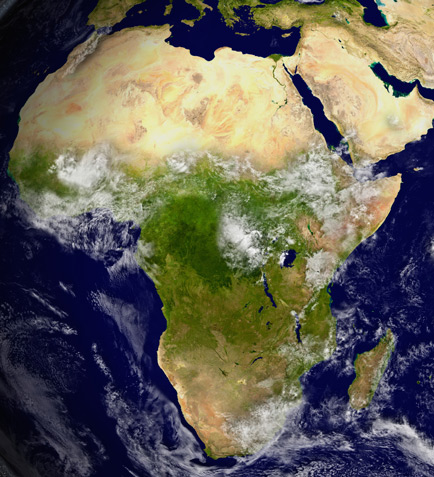The views expressed in our content reflect individual perspectives and do not represent the authoritative views of the Baha'i Faith.
It certainly looks like a lot of people will live on this crowded planet—about 11 billion, to be exact—by the end of this century. Is that too many? Are we doomed?
Many smart people think so. But it may not be so much a question of how many people, as what kind of people. Eleven billion self-interested, wasteful consumers and yes, we could be headed for a Mad Max kind of world. But what if we started behaving like Yacouba Sawadogo?
 The documentary film, The Man Who Stopped the Desert, shows how Sawadogo, an illiterate farmer from Burkina Faso, has transformed the lives of thousands of people across Africa’s Sahel by developing techniques to stop the spread of the Sahara.
The documentary film, The Man Who Stopped the Desert, shows how Sawadogo, an illiterate farmer from Burkina Faso, has transformed the lives of thousands of people across Africa’s Sahel by developing techniques to stop the spread of the Sahara.
At over 9.4 million km2, the Sahara—the world’s largest hot desert–covers most of Northern Africa and compares in size to Europe or the United States. To the south is the Sahel, a 3 million km2 belt of semi-arid tropical savanna. Droughts, overgrazing, and deforestation all contribute to the desertification of this region.
During the 1970s and early 1980s, the Sahel suffered drought after drought. Families abandoned their villages in search of food and water, but Sawadogo stayed, and starting in 1980, he pioneered techniques that halted the approaching desert. Together with Mathieu Ouédraogo, another local innovator, Sawadogo experimented with techniques for rehabilitating damaged soil, including simple approaches traditional to the region called cordons pierreux and zaï holes.
Over a period of more than two decades, Yacouba Sawadogo created a forested area of approximately 20 hectares. Both Sawadogo and Ouédraogo have engaged in extension and outreach efforts to share the techniques, which have spread in the region. To promote the methods, particularly zaï holes, Sawadogo holds bi-yearly Market Days at his farm in the village of Gourga. Attendees from over a hundred regional villages come to share seed samples, swap tips and learn from one another.
Countering the accepted wisdom of traditional land chiefs opposed to new farming techniques, Sawadogo’s work proved controversial. At one point, opposition turned to anger when jealous neighbours burned down newly planted trees and millet fields. Later, government tried to appropriate the land for urban development. Sawadogo continued, undaunted by the opposition, and today his name is synonymous with reversing desertification, drawing the attention of organizations such as the Gates Foundation, which has launched a multi-million dollar research and investment program for local solutions in Africa.
According to Chris Reij, facilitator of the African Re-greening Initiatives at the Centre for International Cooperation, who has followed desert reclamation work over the past 25 years, “Yacouba single-handedly has had more impact on… conservation than all the national and international researchers put together. In this region tens of thousands of hectares of land that was completely unproductive has been made productive again thanks to the techniques of Yacouba.”
The Baha’i teachings praise such sterling character:
The light of a good character surpasseth the light of the sun and the radiance thereof. Whoso attaineth unto it is accounted as a jewel among men. The glory and the upliftment of the world must needs depend upon it. – Tablets of Baha’u’llah, p. 36.
We see the wisdom in that statement when we consider the attributes of Yacouba’s character: creativity, self-sacrifice, courage, perseverance and a willingness to serve others. Like the sun, which energizes growth, a good character can energize a village, a region, or beyond. As Abdu’l-Baha once said, detached souls with noble ideals are “the rays of the Sun of Reality who will illumine all the continents…blowing the breath of life over all the regions.”
Interestingly, restoring vegetation creates climatic feedback loops that increase rainfall. Analysis of satellite images and rainfall in the Sahel between 1982 and 1999 show that 10 to 20 percent more rain falls where new vegetation now grows.
Estimates say that 70,000 km2 of forest is restored annually around the world, often in conjunction with agricultural restoration. Harnessing people’s affinity for trees could be a key to launching large-scale reforestation schemes and fighting poverty, according to Reij. Indeed, he reports that African farmers are already taking to forest restoration in a big way.
We rarely hear good conservation news from northern Africa, but farmer-managed natural regeneration of degraded land has taken hold in several areas. In part of Niger, for example, farmers have restored five million hectares of degraded land, largely through tree planting in what Reij calls the largest environmental transformation in the Sahel region, if not in all of Africa.
Such efforts have a great many positive social and ecological results that contribute to the sustainability of reforestation projects. Reij points out that trees reduce temperatures, wind speeds, and evaporation, sequester carbon and increase biodiversity. They can produce both fodder for livestock as well as fruit and edible vitamin-rich leaves for people. Some species fix atmospheric nitrogen to enhance soil fertility. The social benefits include improved household food security due to the more productive, drought-resistant farming systems, and thus less hunger, poverty, and lower infant mortality, not to mention sharply reduced firewood collection time for women.
Studies also indicate that investing in natural regeneration and agroforestry makes economic sense for farmers. One study showed an internal rate of return of 31 percent on investment in re-greening over 20 years. The African Re-greening Initiatives program, which is built on these local successes, eschews the big conventional projects that require vast sums of money. In the African context, farmer-led reforestation appears to be much more successful than large-scale reforestation schemes because farmers themselves have a sense of ownership of their trees.
Restoration projects at the grassroots level clearly depend on the active participation of local farmers, as well as other stakeholders. Successful landscape restoration is less a technical problem than a social process, one that requires unity of thought and action—and strong moral leadership through the power of example.
That’s why a future populated by people like Yacouba could turn into a beautiful place.



 The light of a good character surpasseth the light of the sun and the radiance thereof. Whoso attaineth unto it is accounted as a jewel among men. The glory and the upliftment of the world must needs depend upon it. –
The light of a good character surpasseth the light of the sun and the radiance thereof. Whoso attaineth unto it is accounted as a jewel among men. The glory and the upliftment of the world must needs depend upon it. – 












Comments
Sign in or create an account
Continue with Googleor